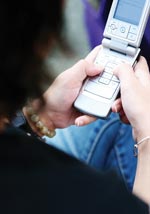
| Home : ITU News magazine | |||||||||||||
Action Plan for an early-warning systemITU participated in the forming of the United Nations International Strategy for Disaster Reduction at the World Conference on Disaster Reduction, which was held in Kobe, Japan, in January 2005, very soon after the tsunami disaster. ITU also took part in the Ministerial Meeting on Regional Cooperation on Tsunami Early Warning in Phuket, Thailand, later the same month. And substantial effort has since been put into coordinating and working with other bodies. Motivated by the need for new telecommunication standards in the wake of the disaster, ITU–T also developed its Action Plan for Standardization on Telecommunications for Disaster Relief and Early Warning. The Telecommunication Standardization Advisory Group (TSAG) agreed to this plan in March 2005. At a TSAG meeting in Geneva in November 2005, ITU–T Study Group 2 was designated as the Lead Study Group for Telecommunications for Disaster Relief/Early Warning. In addition, all study groups were encouraged to increase their activities in defining Recommendations and other materials (such as handbooks) and to provide feed-back to TSAG and Study Group 2 on actions taken and proposals for improving the Action Plan. Partnership Coordination PanelITU–T Recommendations already produced in the field include specifications that allow for preference to be given to emergency calls in a disaster. Additionally, ITU–T established in 2003 a Partnership Coordination Panel on Telecommunications for Disaster Relief (PCP-TDR), providing a channel to exchange views and experiences. PCP-TDR gathers people from various bodies working on relevant standardization fields, as well as representatives of such relief organizations as the United Nations High Commissioner for Refugees (UNHCR), the UN Office for Coordination of Humanitarian Affairs (UNOCHA), the International Federation of Red Cross and Red Crescent Societies (IFRC), and Télécoms Sans Frontières (TSF), which is a partner in ITU’s Connect the World initiative. A workshop will take place in October 2006 that will bring together such organizations to review current developments in early-warning systems and telecommunications for disaster relief, covering all areas that can benefit from standardization and ensuring that activities in this area are well coordinated. Crucial RecommendationsA number of ITU–T Recommendations for call priority schemes seek to ensure that relief workers can get communication lines when they need to. For example, E.106 defines the International Emergency Preferential Scheme (IEPS), which aims to give emergency personnel a higher probability of successful communication using the public network at times when it is in high demand, such as in emergencies. There are also Recommendations that extend call priority to internet protocol (IP)-based systems designed by ITU, such as IP-Cablecom, as well as Recommendations covering telecommunication network management in emergencies (M.3350) and a framework to support emergency communications in a next-generation network (Y.1271). Complementary to the need to provide call priority during emergencies is the ability to deliver warnings. The new Recommendation H.460.21 provides a message broadcast mechanism in H.323 systems, which are deployed worldwide for voice over IP (VoIP) communications. This mechanism is akin to that of cell broadcasts for mobile systems and can be used by network operators and service providers to deliver early warning messages via the short message service (SMS) to a large number of users without overloading the network infrastructure.
SOS by SMSRaising money to help disaster victims is an important area of activity. In December 2005, ITU–T Study Group 2 agreed on the allocation of an international SMS number (+979 0767) to the United Nations International Children’s Emergency Fund and the International Federation of the Red Cross and Red Crescent Societies. It allows the two organizations to launch relief campaigns across national boundaries, using a recognizable and non-changing number. Texting emerged as a popular way to contribute to relief efforts following the 2003 earthquake in Bam in the Islamic Republic of Iran, as well the Indian Ocean tsunami. Challenges for the futureITU–T has taken note of the report from the Second Phase of the World Summit on the Information Society in November 2005, in particular paragraph 91 of the Tunis Agenda for the Information Society. This paragraph highlights the important role of information and communication technologies (ICT) for disaster early warning, management and emergency communication. ITU–T will contribute to international efforts to implement those aims. In particular, ITU–T standards will be essential to make international early-warning systems practical and effective.
Also, it is necessary to disseminate advice on “best practice” regarding actions to be taken from when a warning of a natural disaster is issued to relief operations, including the crucial question of information flows among all those concerned. In deploying telecommunications for this purpose, the most effective approach is to make sure it is highly focused, taking into account four distinct communication channels:
In general, it is necessary to define, together with relevant partners, the need for extensions or add-ons to globally accepted standards, so that early warning and disaster relief capabilities can be introduced into already deployed telecommunication systems and networks. New systems such as next-generation networks (NGN) should have built-in features that support emergency communications, using globally defined standards. ITU–T will continue to pursue one of its core missions of delivering standards that allow systems developers to add, in an interoperable and consistent fashion, facilities to their systems that can reliably respond in emergencies.
|
|||||||||||||
 Standardization work behind early-warning systems and disaster relief
Standardization work behind early-warning systems and disaster relief


